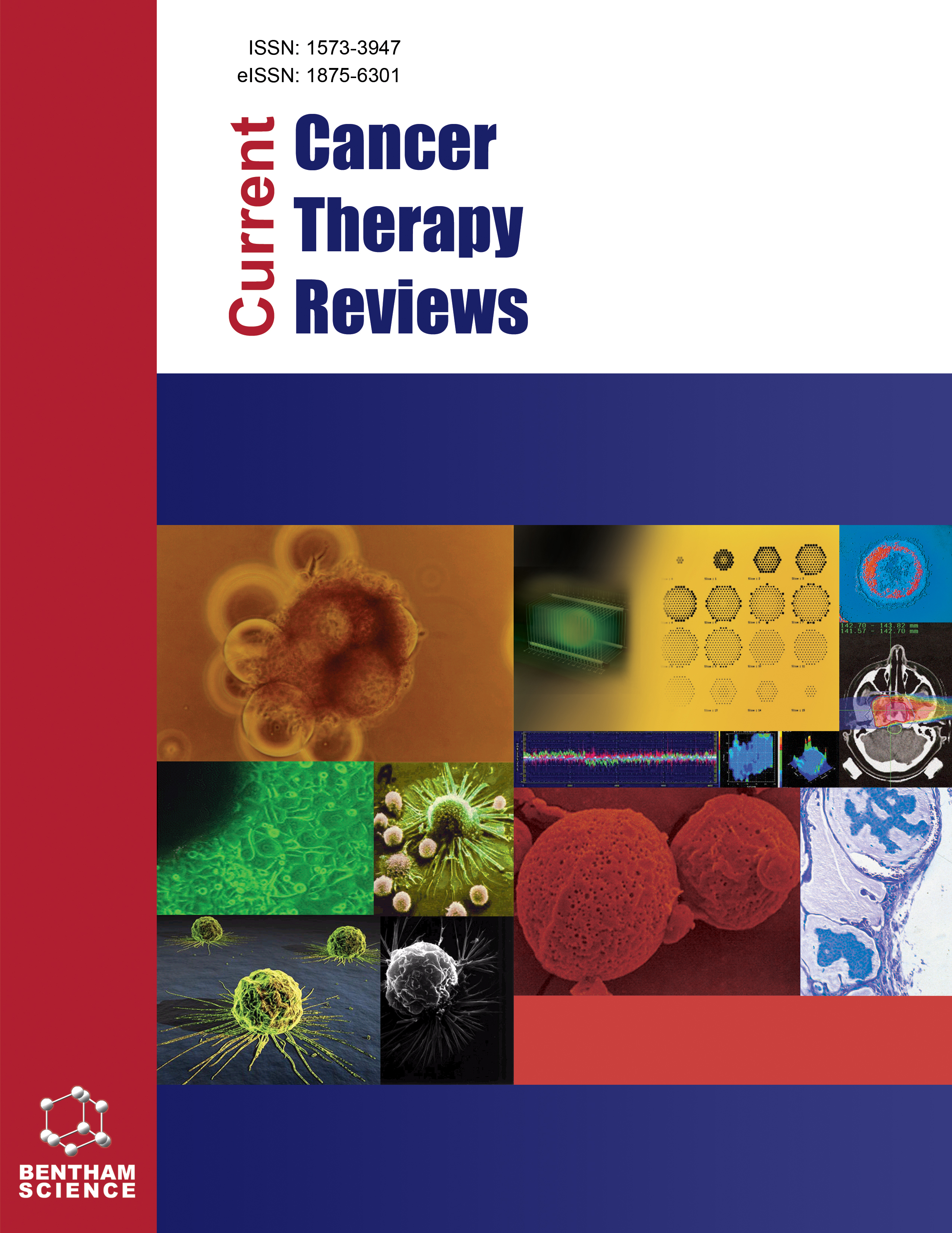- Home
- A-Z Publications
- Current Cancer Therapy Reviews
- Previous Issues
- Volume 1, Issue 2, 2005
Current Cancer Therapy Reviews - Volume 1, Issue 2, 2005
Volume 1, Issue 2, 2005
-
-
Vaccine Therapy of Melanoma: An Update
More LessAuthors: Marie-France Demierre, Susan M. Swetter and Vernon K. SondakObjective: To review recent epidemiologic studies of vaccination and melanoma risk as well as critically discuss the different melanoma vaccines under investigation in multicenter phase III melanoma vaccine trials. Data Sources: A retrospective review of the literature. Study Selection: Studies included those on the risk of melanoma and vaccination, historically relevant data, and ongoing or recently published phase III melanom Read More
-
-
-
Current Strategy in the Treatment of Metastatic Renal Cell Carcinoma
More LessThe strategy in the treatment of metastatic renal cell carcinoma (MRCC) is based on prognostic factors for survival. General performance status, delay from the diagnosis of primary tumor to occurrence of metastases, number of metastatic sites or site of metastases (lung, liver) and biological changes such as hemoglobin value, calcium value, and sedimentation rate are reported as the most predictive factors for survival. The f Read More
-
-
-
RUNX3 and Retinoic Acid Receptor β DNA Methylation as Novel Targets for Gastric Cancer Therapy
More LessAuthors: Eiichi Tahara and Reuben LotanMethylation of CpG islands in many tumor suppressor genes with or without changes in histone acetylation is an important mechanism of gene silencing during the development of different types of cancer. There are at least two types of CpG island methylator phenotypes in intestinal- and diffuse -types of gastric cancer. Hypermethylation of the p16 and of hMLH1 promoters is preferentially found in intestinal-type gastric ca Read More
-
-
-
Intraepithelial Neoplasia, Dysplasia and Early Cancer of the Digestive Tract: Modifications in Terminology
More LessAuthors: Karel Geboes, Nadine Ectors, Karen Geboes and Rene LambertCancer of the digestive tract is a major cause of cancer-associated morbidity and mortality worldwide. Secondary prevention and treatment of early lesions is extremely important because the etiology of gastrointestinal cancer remains largely unknown. Precursor lesions can be identified with imaging techniques and histology. The macroscopic pattern seen during endoscopy includes polyps and non-polypoid lesions. The m Read More
-
-
-
Expression of Cell Cycle Regulators in Thyroid Neoplasms Originating from Follicular Cells
More LessBy Yasuhiro ItoThyroid carcinoma arising from normal follicular cells is generally slow-growing with an excellent prognosis if competently resected. However, once the tumor dedifferentiates and becomes undifferentiated (anaplastic) carcinoma, it becomes one of the most aggressive malignancies. Such a polarized characteristic is quite unique yet typical of thyroid carcinoma. To date, many researchers have studied differences in the chara Read More
-
-
-
Unknown Primary Squamous Cell Carcinoma of the Head and Neck
More LessBackground: Squamous cell carcinoma metastatic to the neck from an unknown head and neck primary site is relatively uncommon and presents a challenging diagnostic and therapeutic dilemma. Methods: Review of the pertinent literature. Results: Diagnostic evaluation includes fine needle aspirate of the neck mass, chest roentgenography, computed tomography, and/or magnetic resonance imaging of the head and neck, f Read More
-
-
-
Androgen Receptor Coregulatory Proteins as Potential Therapeutic Targets in the Treatment of Prostate Cancer
More LessAuthors: Hannelore V. Heemers and Donald J. TindallProstate cancer (PCa) is the most frequently diagnosed cancer and the second leading cause of cancer death in western men, and as such constitutes a significant health problem. The male sex steroids, androgens, have long been recognized as major contributors to the progression of PCa. Still today, standard therapy for PCa is aimed at removing androgens and/or blocking the action of androgens. Although most PCas Read More
-
-
-
Autocrine Motility Factor Possesses a Possibility of Developing a New Target for Anti-Cancer Treatment
More LessAuthors: Tatsuyoshi Funasaka, Takashi Yanagawa, Victor Hogan and Avraham RazAutocrine motility factor (AMF) is a type of tumor-secreted cytokine stimulating cell motility via AMF receptor (AMFR)-mediated signaling pathways. There are many reports that enhanced AMF levels and AMFR overexpressions are correlated with the tumor progression and its malignancy. It is thought previously that AMF is a tumor-specific factor functioning in an autocrine manner, however, recent studies show that tumor-secr Read More
-
-
-
Garlic and its Organosulfides as Potential Chemopreventive Agents: A Review
More LessAuthors: Annu Arora, Chitra Tripathi and Yogeshwer ShuklaThere are many biological plausible reasons, which showed that plant food could prevent/delay the appearance of many diseases including cancer. Garlic has been reported to possess therapeutic properties from centuries and is probably the most widely studied medicinal plant. Garlic contains a number of organosulfur compounds such as SAC, S-allyl mercaptocysteine, allicin, ajoene, DAS and other structurally related compou Read More
-
Volumes & issues
-
Volume 21 (2025)
-
Volume 20 (2024)
-
Volume 19 (2023)
-
Volume 18 (2022)
-
Volume 17 (2021)
-
Volume 16 (2020)
-
Volume 15 (2019)
-
Volume 14 (2018)
-
Volume 13 (2017)
-
Volume 12 (2016)
-
Volume 11 (2015)
-
Volume 10 (2014)
-
Volume 9 (2013)
-
Volume 8 (2012)
-
Volume 7 (2011)
-
Volume 6 (2010)
-
Volume 5 (2009)
-
Volume 4 (2008)
-
Volume 3 (2007)
-
Volume 2 (2006)
-
Volume 1 (2005)
Most Read This Month
Article
content/journals/cctr
Journal
10
5
false
en


